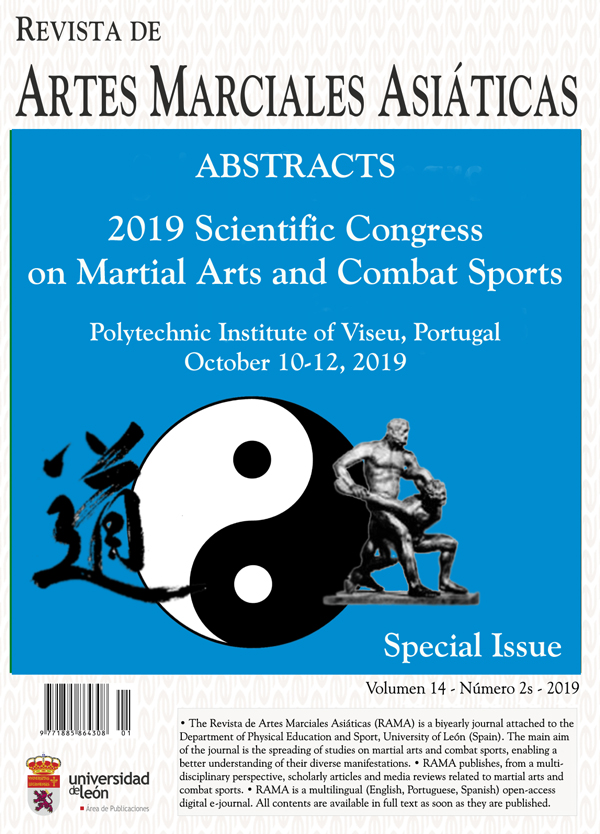Karate's ambiguity: Traditional martial art or modern combat sport
DOI:
https://doi.org/10.18002/rama.v14i2s.6000Palabras clave:
Martial arts, combat sports, traditional karate, toti, gendai, budo, bouts contests, kata contestsResumen
After a radical conversion of the old Okinawan, anti-samurai martial art toti in the 1920s, a new, in effect Japanese modern combat sport, karate, came into being. The very first karate sports contest already took place in 1930. But, at the end of 1950s, karate started to be exported to the Western world as a traditional martial art of Japanese samurai, even if the samurai had not known karate. That then already omnipresent doctrine has allowed no other perception despite the fact that, globally, the prevalent phenomenon in the field has been karate sports contests in bouts and katas. Exposing the concept of karate as a traditional martial art to be an unhistoric, artificial ideological superstructure, this study is based on more than 50 years of accumulated scepticism of the author that has been confirmed through communication with students of various karate styles and the evaluation of several publications and studies. It is hoped that the findings of this basic study will encourage the sports scientific community to favor further research directed to indisputable and unambiguous explanation of karate.
Descargas
Métricas alternativas
Citas
Cynarsky, W.J. (2014). The European karate today: The opinion of experts. Ido movement for culture. Journal of martial arts anthropology, 14(3), 10-21. doi: https://doi.org/10.14589/ido.14.3.2
Funakoshi, G. (1975). Karate-do My Way of Life. Tokyo, New York, San Francisco: Kodansha America.
Haines, B. A. (1968). Karate's History and Traditions. Tokyo: Rutland.
Jakhel, R. (1998). Modern Sports Karate. Basics of Technique and Tactics. Aachen: Meyer&Meyer Verlag.
Jakhel, R. (2017-18). Borilni športi – 2. del: Karate in sorodne discipline. Kompendij predavanj [Combat sports – Vol. 2: Karate and related disciplines. Compendium of lectures]. Ljubljana: Faculty of Sport.
Jakhel, R., & Pieter, W. (2013). Changes in participation motives in karate 1970-1999. Ido movement for culture. Journal of martial arts anthropology, 13(1), 48-57. doi: https://doi.org/10.14589/ido.13.1.7
Kanazawa, H. (2011). Kumite shotokan karate. Masberg: Plaidt.
Lind, W. (1995a). Budo – Der geistige Weg der Kampfkünste. O.W. Barth Verlag: Bern, München, Wien.
Lind, W. (1995b). Die klassische Kata – Der geistige Herkunft und Praxis des traditionellen Karate. O.W. Barth Verlag: Bern, München, Wien.
Lind, W. (1997). Okinawa Karate – Geschichte und Tradition der Stille. SVB Sportverlag: Berlin.
Lind, W. (1999). Das Lexikon der Kampfkünste. SVB Sportverlag: Berlin.
Nakayama, M. (1978). Best karate: Kumite 1. Tokyo: Kodansha International.
Swenen, F. (2009). The Evolution of Karate: From Secret Martial Art to Worldwide Cultural Sport. Retrieved from http://sfdojo.be/wp-content/uploads/2014/05/ThesisBudai.pdf
Descargas
Publicado
Cómo citar
Número
Sección
Licencia
Derechos de autor 2019 Rudolf Jakhel

Esta obra está bajo una licencia internacional Creative Commons Atribución-NoComercial-CompartirIgual 4.0.
Los autores que publican en esta revista están de acuerdo con los siguientes términos:
- Los autores ceden de forma no exclusiva los derechos de explotación (reproducción, distribución, comunicación pública, transformación) a la Universidad de León, por lo que pueden establecer, por separado, acuerdos adicionales para la distribución no exclusiva de la versión de la obra publicada en la revista (por ejemplo, alojarlo en un repositorio institucional o publicarlo en un libro), con un reconocimiento de su publicación inicial en esta revista.
- Este trabajo se encuentra bajo la Creative Commons Attribution-NonCommercial-ShareAlike 4.0 International License. Puede consultarse desde aquí la versión informativa y el texto legal de la licencia.
- Se permite y se anima a los autores a difundir electrónicamente las versiones pre-print (versión antes de ser evaluada) y/o post-print (versión evaluada y aceptada para su publicación) de sus obras antes de su publicación, ya que favorece su circulación y difusión más temprana y con ello un posible aumento en su citación y alcance entre la comunidad académica.











